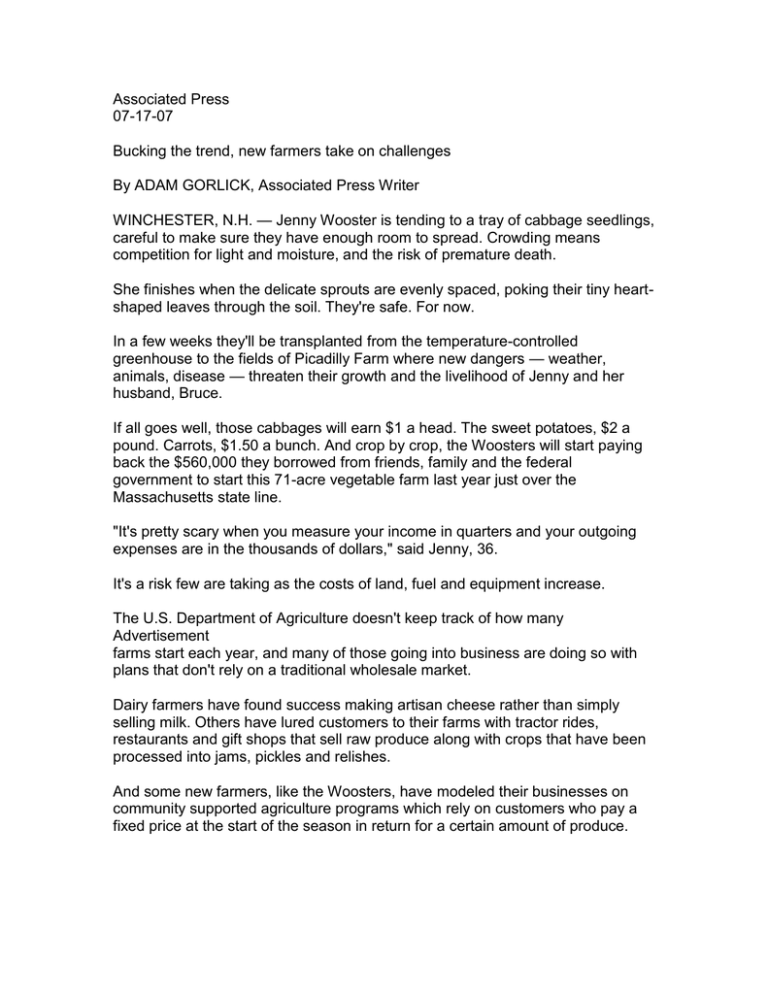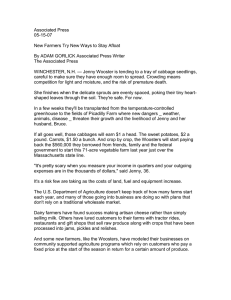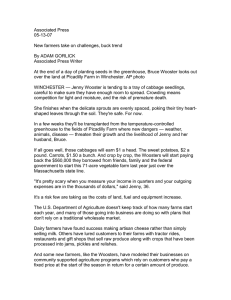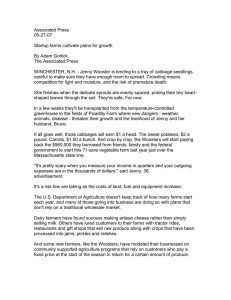
Associated Press
07-17-07
Bucking the trend, new farmers take on challenges
By ADAM GORLICK, Associated Press Writer
WINCHESTER, N.H. — Jenny Wooster is tending to a tray of cabbage seedlings,
careful to make sure they have enough room to spread. Crowding means
competition for light and moisture, and the risk of premature death.
She finishes when the delicate sprouts are evenly spaced, poking their tiny heartshaped leaves through the soil. They're safe. For now.
In a few weeks they'll be transplanted from the temperature-controlled
greenhouse to the fields of Picadilly Farm where new dangers — weather,
animals, disease — threaten their growth and the livelihood of Jenny and her
husband, Bruce.
If all goes well, those cabbages will earn $1 a head. The sweet potatoes, $2 a
pound. Carrots, $1.50 a bunch. And crop by crop, the Woosters will start paying
back the $560,000 they borrowed from friends, family and the federal
government to start this 71-acre vegetable farm last year just over the
Massachusetts state line.
"It's pretty scary when you measure your income in quarters and your outgoing
expenses are in the thousands of dollars," said Jenny, 36.
It's a risk few are taking as the costs of land, fuel and equipment increase.
The U.S. Department of Agriculture doesn't keep track of how many
Advertisement
farms start each year, and many of those going into business are doing so with
plans that don't rely on a traditional wholesale market.
Dairy farmers have found success making artisan cheese rather than simply
selling milk. Others have lured customers to their farms with tractor rides,
restaurants and gift shops that sell raw produce along with crops that have been
processed into jams, pickles and relishes.
And some new farmers, like the Woosters, have modeled their businesses on
community supported agriculture programs which rely on customers who pay a
fixed price at the start of the season in return for a certain amount of produce.
But the startup farms are clearly outpaced by those going out of business. And
the decreasing number of smaller farms could have an impact on the nation's
food supply.
Fewer local farms could lead to a lack of diversity in available crops, a hit to rural
economies and a more vulnerable supply as dependence grows on large
centralized farms that transport their harvests across the country.
"I wouldn't say there is a disaster looming," said Jerry DeWitt, director of Iowa
State University's Leopold Center for Sustainable Agriculture. "But if there's
just one big problem on a huge farm — whether it's something like bad weather
or terrorism — that could have a dramatic, dramatic impact on the rest of the
food system."
Between 2005 and 2006, the number of farms in America dropped by 9,000.
Currently, there are just more than 2 million farms, 160,000 fewer than there
were 20 years ago, according to the USDA.
"Kids who grow up on a farm are being encouraged to leave and make money
elsewhere," said Judith Gillan, director of the Belchertown, Mass.-based New
England Small Farm Institute, which provides workshops and assistance for
people thinking about starting a farming business.
"The idea that a farm in itself could provide a sufficient income for a family is
rarely a reality," Gillan said. "But it can happen."
And the Woosters are betting all they have that it will.
Why?
"Farming is very here and now and the results are right in front of you all the
time," Bruce said as he watered trays of onions, shallots and leeks in the
greenhouse. "You depend on the food, and your community depends on the
food."
The Woosters don't come from farming families. They grew up in the suburbs —
Jenny on the west side of Cincinnati and Bruce in Concord, Mass., — and it
wasn't until the early 1990s when they got their first jobs on small farms. Jenny
left Washington University in St. Louis with a degree in anthropology and
women's studies but no clear career path. Bruce, 37, graduated from Stanford
University as a self-designed "human ecology" major "more interested in figuring
out the meaning of life than in a particular occupation."
They met while working on Brookfield Farm, a vegetable and livestock operation
in Amherst, Mass., in 2000. A year later, they took jobs on Appleton Farms in
Ipswich, Mass., and soon began thinking about starting their own farm and
family.
Each liked the payoff of having something to show for their work at the end of the
day. But more importantly, the idea of producing wholesome food for their
community became a mission, not just a career.
With a decade of agriculture experience, a business plan and more debt than
either ever had, they bought this defunct dairy farm for $420,000. They borrowed
another $140,000 for equipment and other costs, and moved in April 2006 with
their 5-month-old daughter, Beckley.
They've divided their time during the last year between honing their marketing
strategy and preparing for the upcoming growing season. Much of their days are
spent planting seeds and making sure the fledgling plants are growing properly in
their two greenhouses.
And there are other chores. A tool storage cabinet needs to be built. The tractors
need to be prepared for plowing. Beckley has to be driven to daycare.
Evenings are usually spent at the computer, going over expenses and customer
orders. And sometimes, there's time for a reality check.
"We feel a real sense of freedom, even though we have the weight of our debt,"
Jenny said. "And I didn't have to ask myself once today, 'why am I doing this?"'
And selling their crops as shares through a community supported agriculture
system helps relieve some of the risk.
For about $500, shareholders can come to Picadilly Farm once a week and
choose a certain amount of eight or nine items from whatever crops are
harvested. Because the money is collected at the start of the growing season,
the Woosters will have the money in hand even if bad weather deals them a
lousy harvest.
Along with the financial reasoning, the system fits in with the Wooster's push for
people to have a direct connection with their food.
Right now, they're struggling to make those connections. Their goal was to have
60 shareholders by the start of this season, but have so far lined up only 20.
Their advertising campaign has relied on their Web site, flyers handed out in their
community and meeting people at local agriculture fairs.
They're setting up other deals with co-ops and neighboring farmers in New
Hampshire, Massachusetts and Vermont to ensure they'll gross the $225,000
they need to pay their mortgage and cover their operating costs. But they might
have to consider selling wholesale, which exposes them to more risk.
"If they have a bad year with too much rain or not enough rain or an early frost,
they could lose all their equity in one fell swoop from Mother Nature," said James
Radintz, director of the USDA's Farm Service Agency loan division.
The agency issued about $1 billion in low-interest loans last year to new farmers,
who the USDA classifies as having been in business for less than a decade.
Radintz doesn't know the success rate of new farms, but said he keeps hearing
how hard it is for new farmers to succeed with so much debt.
"I said 'you guys are crazy,"' vegetable farmer Tracie Smith recalls telling Jenny
when the two met for dinner a few months ago. "We're all crazy. You have to be
to be a farmer. We just don't get the kind of compensation that we should for all
the work we do, but you can only charge so much for a vegetable."
Smith has been growing vegetables on Tracie's Community Farm in Sullivan for
the past nine years and has made a profit of about $10,000 during each of the
past three seasons. Unlike the Woosters, she's farming on someone else's land
and has no debt.
"They're going to be working their entire lives to pay off their loans," she said.
The Woosters know they have little margin for error. Their first federal loan
payment of $12,000 is due in September and they plan on just covering their
costs during the next three years. But they need to turn a profit by 2012, when
they'll have to start repaying their friends a $120,000 loan. If things don't look
good by then, they know they might have to move and take other jobs to pay
their debts.
They don't have disability or crop insurance, and there are no government
subsidies for the vegetables they grow. They'd like to be able to save some
money for their retirement so they aren't forced to sell their land when they get
older.
"We're never going to have money for nice vacations and fancy private school
tuitions," Jenny said.
By mid-April, Picadilly Farm's 71 acres were still waiting to be plowed. An
unusually cold start to spring followed by days of heavy rains pushed back their
planting schedule by about two weeks.
But there are signs of luck. Had Jenny and Bruce planted before the rainstorms,
chances are the young crops would've been ruined. And their land is sandy
enough so it will drain quickly.
Meanwhile, the seedlings sit ready in the greenhouse — sprouts of cabbages,
onions, broccoli and peppers — wisps of hope that profits will eventually outgrow
the risks.
Copyright © 2006 Associated Press. All rights reserved. This material may not be
published, broadcast, rewritten or redistributed.








